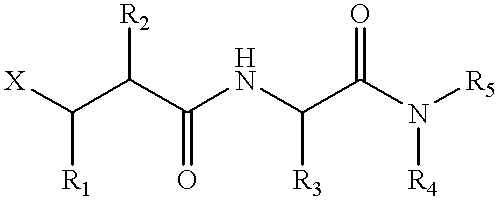Metalloproteinase inhibitors
a technology of metalloproteinase inhibitors and inhibitors, which is applied in the direction of amide active ingredients, drug compositions, medical preparations, etc., can solve the problems of cachexia and anorexia, the relative contribution of individual mmps in any of the above disease states is not yet fully understood, and the accumulation of excessive tnf can be lethal
- Summary
- Abstract
- Description
- Claims
- Application Information
AI Technical Summary
Problems solved by technology
Method used
Image
Examples
examples 1 and 3-33
which follow serve to illustrate embodiments of the invention:
The following abbreviations have been used throughout:
DIPE Diisopropyl ether
DMAP 4-Dimethyl-aminopyridine
DMF N,N-Dimethylformamide
EDC N-Ethyl-N'-(3-dimethylaminopropyl)carbodiimide hydrochloride
HOBt 1-Hydroxybenzotriazole
NMR Nuclear magnetic resonance
NMM N-methylmorpholine
NaHMDS Sodium bis(trimethylsilyl)amide
TESCI Chlorotriethylsilane
THF Tetrahydrofuran
.sup.1 H and .sup.13 C NMR spectra were recorded using a Bruker AC 250E spectrometer at 250.1 and 62.9 MHz, respectively. Elemental microanalyses were performed by either CHN Analysis Ltd,. Alpha House, Countesthorpe Road, South Wigston, Leicester LE8 2PJ, UK, or MEDAC Ltd., Dept. of Chemistry, Brunel University, Uxbridge, Middlesex UB8 3PH, UK.
example 1
2S-Cyclopentyl-3R-[2,2-dimethyl-1S-(methylcarbamoyl)propylcarbamoyl]-5-methylhexanoic acid
##STR17##
STEP A:
4R-Benzyl-3-cyclopentylacetyl-oxazolidin-2-one
Cyclopentyl acetic acid (59 ml, 470.4 mmol) was taken up in dry THF (1 l) and cooled to -78.degree. C. under argon. Pivaloyl chloride (58 ml, 470.4 mmol) and triethylamine (85 ml, 611.5 mmol) were added and the reaction mixture stirred for 15 min at -78.degree. C. and then warmed to 0.degree. C. and stirred for 40 min before cooling back to -78.degree. C. In a separate flask, 4R-benzyl-oxazolidin-2-one (100 g, 564.5 mmol) was dissolved in dry THF (1 l) and the solution was cooled to -78.degree. C. under argon. To this stirred solution was added 2.5 M n-butyllithium in hexanes (226 ml, 565 mmol). After the addition was complete the resulting solution was cannulated into the former reaction flask and the mixture was stirred for a further 15 minutes at -78.degree. C. before warming to room temperature and stirring overnight. The reactio...
example 2
INTERMEDIATE EXAMPLE 2
4-tert-Butylcyclohexylacetic acid
##STR18##
STEP A:
(4-tert-Butylcyclohexylidene)acetic acid methyl ester
4-tert-Butylcyclohexanone (8.62 g, 56 mmol) was dissolved in toluene (200 ml). Methoxycarbonylmethylenetriphenylphosphorane (56.1 g, 168 mmol) was added with stirring and the reaction mixture was heated under reflux for 3 days. The solvent was removed in vacua. The residue was dissolved in hot hexanes (100 ml) and cooled to room temperature. The precipitate was filtered off and the filtrate was evaporated in vacuo to afford a yellow oil which was then purified by chromatography (silica gel, hexane / ethyl acetate, 2:1 as eluant) to give the title compound as an oil (10.78 g, 92%). .sup.1 H-NMR; .delta. (CDCl.sub.3) 5.60 (1H, s), 3.87 (1H, m), 3.69 (3H, s), 2.38-2.10 (2H, m), 2.03-1.77 (3H, m), 1.36-1.02 (3H, m) and 0.87 (9H, s).
STEP B:
(4-tert-Butylcyclohexyl)acetic acid methyl ester
(4-tert-Butylcyclohexylidene)acetic acid methyl ester (10.78 g, 51.3 mmol) was dis...
PUM
| Property | Measurement | Unit |
|---|---|---|
| temperature | aaaaa | aaaaa |
| temperature | aaaaa | aaaaa |
| temperature | aaaaa | aaaaa |
Abstract
Description
Claims
Application Information
 Login to View More
Login to View More - R&D
- Intellectual Property
- Life Sciences
- Materials
- Tech Scout
- Unparalleled Data Quality
- Higher Quality Content
- 60% Fewer Hallucinations
Browse by: Latest US Patents, China's latest patents, Technical Efficacy Thesaurus, Application Domain, Technology Topic, Popular Technical Reports.
© 2025 PatSnap. All rights reserved.Legal|Privacy policy|Modern Slavery Act Transparency Statement|Sitemap|About US| Contact US: help@patsnap.com



